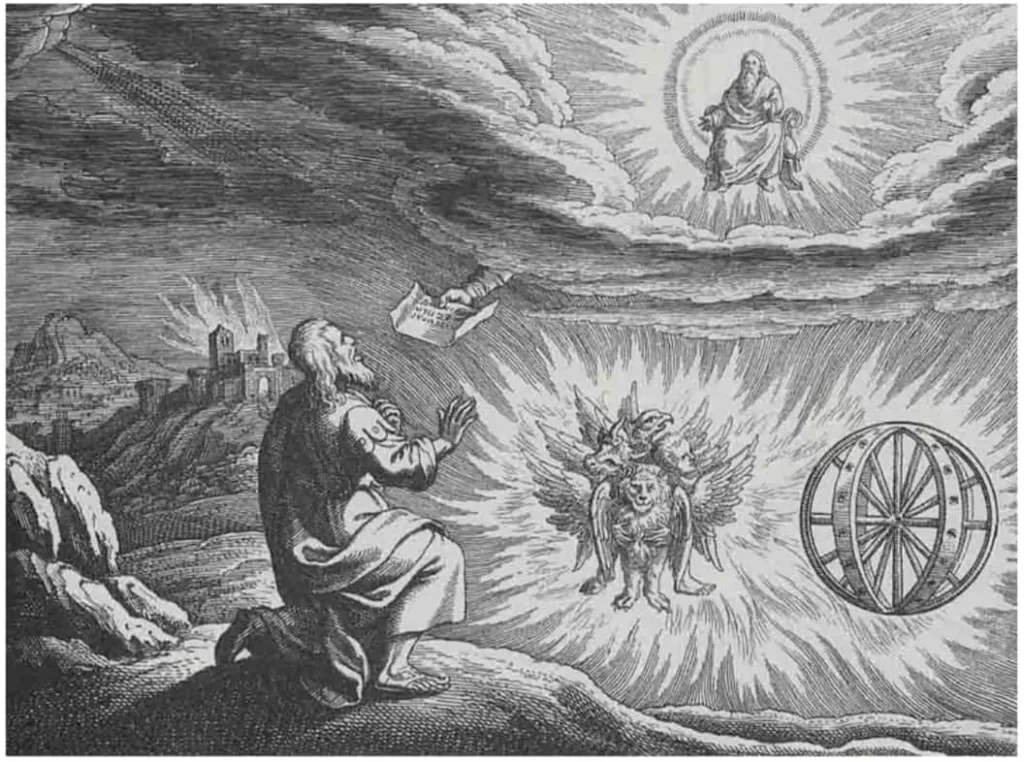“Biblically accurate angels” refer to depictions of angels based on diverse, often complex or abstract descriptions found in the Bible, which significantly contrast with the conventional human-like figures with wings and halos commonly seen in modern culture.
Understanding their biblical depiction is of great importance as it enhances our understanding of the spiritual realm and the divine plan. In this article, we will explore the description, roles, and hierarchy of angels as depicted in the Bible. We will delve into how the Bible describes angels, where in the Bible their descriptions can be found, their physical appearance and symbolism, the hierarchy of angels, and the characteristics and roles of different tiers within the angelic hierarchy. By the end of this article, you will have a comprehensive understanding of biblically accurate angels and their significance in biblical theology.
Table of Contents
How Does the Bible Describe Angels
Angels play a significant role in biblical narratives, and understanding their depiction in the Bible is crucial for a comprehensive understanding of the spiritual realm. In this section, we will explore the biblical references to angels, their characteristics and attributes, as well as their role and purpose in biblical narratives.
Related: What Does The Bible Say The Devil Looks Like
Biblical References to Angels
The Bible contains numerous references to angels, both in the Old and New Testaments. These references provide insights into the nature and existence of these celestial beings. Some notable examples include:
- The angel Gabriel, who appeared to the prophet Daniel to deliver messages from God (Daniel 8:16; 9:21).
- The angelic host that appeared to the shepherds to announce the birth of Jesus (Luke 2:8-14).
- The angel who rolled away the stone from Jesus’ tomb and proclaimed his resurrection (Matthew 28:2-7).
- The angel who appeared to Mary to announce that she would conceive and bear the Son of God (Luke 1:26-38).
These biblical references serve as evidence of the existence and involvement of angels in the divine plan.
Characteristics and Attributes of Angels According to the Bible
The Bible provides insights into the characteristics and attributes of angels. While their exact nature is beyond human comprehension, the Scriptures offer glimpses into their divine qualities. Some key characteristics and attributes of angels according to the Bible include:
- Holiness: Angels are described as holy beings, serving in the presence of God (Mark 8:38; Luke 9:26).
- Immortality: Angels are immortal and do not experience physical death (Luke 20:36).
- Wisdom: Angels possess wisdom and knowledge beyond human understanding (2 Samuel 14:20).
- Power: Angels are depicted as powerful beings, capable of executing God’s will and performing miraculous acts (Psalm 103:20; 2 Peter 2:11).
- Obedience: Angels are obedient to God’s commands and carry out His will without question (Psalm 103:20; Matthew 6:10).
These characteristics highlight the divine nature of angels and their role as messengers and servants of God.

Role and Purpose of Angels in Biblical Narratives
Angels fulfill various roles and purposes in biblical narratives. They serve as messengers, protectors, guides, and agents of God’s divine intervention. Some of their key roles include:
- Messengers: Angels are often sent by God to deliver important messages to individuals or groups (Luke 1:11-20; Acts 8:26).
- Protectors: Angels are assigned to protect and guard God’s people from harm (Psalm 91:11-12; Daniel 6:22).
- Worshipers: Angels are depicted as worshiping and praising God in heavenly realms (Revelation 5:11-12).
- Executors of Judgment: Angels are involved in executing God’s judgment and carrying out His divine purposes (Genesis 19:1-26; Revelation 16:1).
The role and purpose of angels in biblical narratives demonstrate their active involvement in God’s plan for humanity.
With a deeper understanding of how the Bible describes angels, we can now explore where in the Bible these descriptions can be found.
Where in the Bible Does It Describe Angels
To gain a comprehensive understanding of angels, it is important to explore the key biblical passages that mention them, as well as the stories and events involving these celestial beings. Understanding the context of angelic appearances in the Bible is crucial for interpreting their significance. In this section, we will delve into these aspects.
Key Biblical Passages that Mention Angels
The Bible contains several key passages that mention angels and provide insights into their nature and purpose. Some of these passages include:
- Genesis 3:24: This passage mentions the cherubim guarding the entrance to the Garden of Eden after Adam and Eve were expelled.
- Exodus 3:2-6: Here, an angel of the Lord appears to Moses in the form of a burning bush, delivering God’s message and commissioning him.
- Daniel 10:10-14: In this passage, the prophet Daniel encounters an angel who brings him a message and provides insight into the spiritual realm.
- Matthew 1:20-24: The angel appears to Joseph in a dream, assuring him of the divine origin of Mary’s pregnancy and instructing him to take her as his wife.
- Acts 12:6-11: This passage recounts the story of Peter’s miraculous escape from prison with the help of an angel.
These key passages offer glimpses into the encounters between humans and angels, shedding light on their role in God’s divine plan.
Stories and Events Involving Angels in the Bible
The Bible is replete with stories and events involving angels. These narratives provide a deeper understanding of the interactions between angels and humans. Some notable stories and events include:
- The Fall of Lucifer: The book of Isaiah (Isaiah 14:12-15) and the book of Ezekiel (Ezekiel 28:12-19) describe the fall of Lucifer, who was once an angel but rebelled against God.
- The Annunciation: The angel Gabriel appears to the Virgin Mary to announce that she will conceive and bear the Son of God (Luke 1:26-38).
- The Resurrection: Angels appear at Jesus’ tomb to announce his resurrection to the women who came to anoint his body (Matthew 28:1-7).
- The Ascension: Angels appear to the disciples after Jesus’ ascension into heaven, assuring them of his return (Acts 1:9-11).
These stories and events highlight the significant role that angels play in the biblical narrative and their involvement in pivotal moments of salvation history.
Importance of Understanding the Context of Angelic Appearances in the Bible
Understanding the context of angelic appearances in the Bible is crucial for interpreting their significance. The cultural, historical, and theological context provides valuable insights into the purpose and message behind these encounters. By considering the context, we can discern the intended meaning and relevance of angelic appearances in specific biblical narratives.
By exploring the key passages, stories, and events involving angels in the Bible, we can gain a deeper appreciation for their role and significance in God’s divine plan. In the next section, we will delve into the physical appearance and symbolism of biblically accurate angels.
What Do Biblically Accurate Angels Look Like
The physical appearance of angels as described in the Bible and their symbolic representations provide fascinating insights into their nature and role. Additionally, variations in angelic appearances based on their roles and hierarchy further enrich our understanding. In this section, we will explore these aspects in detail.

Physical Appearance of Angels as Described in the Bible
The Bible provides glimpses into the physical appearance of angels, although their true form may transcend human comprehension. Some descriptions include:
- Radiant and Glorious: Angels are often depicted as beings radiating with glory and light. For example, when the angel appeared to the shepherds to announce the birth of Jesus, they were surrounded by the glory of the Lord (Luke 2:9).
- Human-like: Angels are often described as having a human-like form, with the ability to take on a physical appearance. They can appear as ordinary individuals, sometimes even mistaken for humans. In Hebrews 13:2, it is mentioned that some have entertained angels without knowing it.
- Wings: Many biblical descriptions of angels mention their wings. In Isaiah 6:2, seraphim are described as having six wings, while cherubim are depicted as having four wings (Ezekiel 10:21).
It is important to note that these descriptions are symbolic and metaphorical, aiming to convey the awe-inspiring nature of angels rather than providing a literal representation.
Related: What Do Angel Wings Symbolize?
Symbolic Representations of Angels in Biblical Texts
Angels often serve as symbolic representations of divine attributes or messages in biblical texts. They can embody qualities such as holiness, purity, and divine presence. For example:
- Seraphim: The seraphim, with their fiery appearance and six wings, symbolize the holiness and purity of God (Isaiah 6:2-3).
- Cherubim: Cherubim, often depicted as winged creatures with multiple faces and a combination of human, lion, ox, and eagle features, symbolize the guardianship and presence of God (Ezekiel 10:14).
These symbolic representations highlight the transcendence and divine nature of angels, emphasizing their role as messengers and servants of God.
Variations in Angelic Appearances Based on Their Roles and Hierarchy
Angelic appearances can vary based on their roles and hierarchy within the celestial realm. The Bible suggests that there are different orders or ranks of angels, each with distinct responsibilities. While the exact hierarchy is not explicitly outlined, some variations in appearances can be inferred:
- Archangels: Archangels, such as Michael and Gabriel, are often depicted as powerful beings with significant roles in delivering important messages and carrying out divine tasks (Daniel 10:13; Luke 1:26).
- Seraphim and Cherubim: These angelic beings are often associated with the presence of God and are depicted with unique and awe-inspiring appearances (Isaiah 6:2; Ezekiel 10:1-22).
- Guardian Angels: Guardian angels are believed to have a specific role in protecting and guiding individuals. While their appearances are not explicitly described, they are often portrayed as gentle and comforting beings.
These variations in appearances reflect the diverse roles and responsibilities of angels within the celestial hierarchy.
As we have explored the physical appearance and symbolism of biblically accurate angels, we can now delve into the hierarchy of angels in the next section.
What is the Hierarchy of Angels
The hierarchy of angels in biblical theology provides a framework for understanding the different tiers and roles within the celestial realm. This hierarchical structure helps us comprehend the diverse responsibilities and functions of angels. In this section, we will explore the angelic hierarchy, the different tiers of angels, and their respective roles and responsibilities.

Explanation of the Angelic Hierarchy in Biblical Theology
The angelic hierarchy is a concept that originated from early Christian theologians who sought to understand the organization and order within the celestial realm. While the Bible does not explicitly outline a detailed hierarchy, it does provide hints and references to different orders of angels. The hierarchy is based on the belief that angels are organized into various ranks or tiers, each with its own distinct role and responsibility.
Overview of the Different Tiers of Angels
While the exact structure and number of tiers may vary in different theological traditions, a commonly accepted framework includes the following tiers:
Read Also 9 Types Of Angels And Their Duties
First Tier: The Highest Hierarchy
- Seraphim: Described in Isaiah 6:2-3, they have six wings and praise God with a powerful voice. They are known for their purity and closeness to God.
- Cherubim: Mentioned in Genesis 3:24, they guard the way to the Tree of Life in the Garden of Eden. They are associated with wisdom and divine knowledge.
- Thrones: Mentioned in Colossians 1:16, they are divine bearers of God’s throne and represent His authority and justice.
Second Tier: The Middle Hierarchy
- Dominions: Also known as Lordships, they oversee the duties of lower angels. Mentioned in Ephesians 1:21, they have authority and power and regulate the duties of other angelic beings.
- Virtues: Associated with miracles and blessings, they are mentioned in 1 Corinthians 12:9. They maintain the order of the physical universe.
- Powers: Mentioned in 2 Peter 2:11, they bear conscience and keepers of history. They distribute power among mankind.
Third Tier: The Lowest Hierarchy
- Principalities: Also known as Rulers, they protect religion and guard nations and leaders. Mentioned in Ephesians 3:10, they have authority over earthly rulers.
- Archangels: Well-known angels who act as messengers of God to humans. Some examples include Gabriel, Michael, and Raphael.
- Angels: Closest to humans, they deliver prayers to God and His answers back to humans. They are mentioned throughout the Bible in various interactions with humans.
Conclusion
Throughout this article, we have explored the topic of biblically accurate angels, delving into their description, roles, and hierarchy as depicted in the Bible. Let’s recap the key points discussed:
- We began by understanding the importance of understanding the biblical depiction of angels and the significance of studying them in the context of theology.
- We then explored how the Bible describes angels, looking at biblical references, their characteristics and attributes, as well as their role and purpose in biblical narratives.
- Moving on, we examined where in the Bible angels are described, highlighting key passages and stories involving angelic appearances. We emphasized the importance of understanding the context of these appearances for proper interpretation.
- Next, we delved into the physical appearance of angels as described in the Bible, noting their symbolic representations and variations based on their roles and hierarchy.
- We then explored the hierarchy of angels in biblical theology, providing an overview of the different tiers, their roles, and responsibilities. We discussed archangels, principalities, powers, virtues, dominions, thrones or ophanim, cherubim, and seraphim.
In conclusion, the study of biblically accurate angels offers us insights into the spiritual realm and the divine plan. Understanding their roles, characteristics, and hierarchy enhances our understanding of the biblical narrative and the involvement of these celestial beings in God’s work. By recognizing their significance, we can develop a deeper appreciation for the divine order and the intricate workings of the spiritual realm.
Biblical references: biblegateway.com
FAQ ABOUT BIBLICALLY ACCURATE ANGELS
What are the 7 types of angels in the Bible?
The 7 types of angels in the Bible include archangels, principalities, powers, virtues, dominions, thrones or ophanim, and cherubim.
Who are the most powerful biblically accurate angels?
The archangels, such as Michael and Gabriel, are often considered the most powerful biblically accurate angels.
Who are the 3 main angels of God?
The three main angels mentioned in the Bible are Michael, Gabriel, and Raphael.

As a passionate scholar of theology, angelology, and biblical studies, I, Chandra Dona, am dedicated to the exploration of the celestial and divine realms as mentioned in various scriptures. I am an author committed to inspiring thoughtful discourse and fostering a deeper understanding and appreciation of our spiritual heritage, through rigorous academic exploration and engaging writings on the complex and beautiful aspects of belief.







